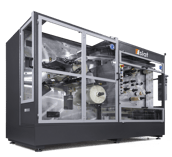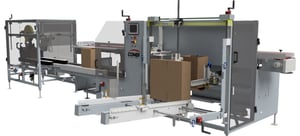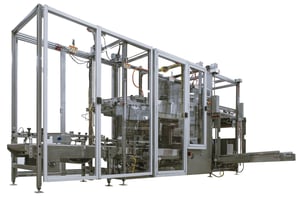With the press of a button, Combi’s high-speed case erectors can switch from assembling right-hand boxes to left-hand boxes. We’re not aware of another ambidextrous case erector on the market. You can see it in action here.
Many people who work in end-of-line packaging operations won’t care. But for contract manufacturers and copackers, a single machine that can handle both right- and left-handed boxes can be a game-changer.
“If you ask, ‘What hand boxes do you buy?’ most customers wouldn’t know. First, you’d have to explain it to them and then they’d have to go look,” says Paul Hart, Senior Sales Application Engineer at Combi Packaging Systems LLC.
“On the other hand, copackers are getting product from someone else and packaging it for them,” Hart says. “Often, they’re receiving corrugated from the customer too.” Sometimes they get right-hand cases, other times left-hand. It can change from day to day or shift to shift. They need flexibility and fast equipment changeovers.
Case erectors typically only work one way: You need a right-handed erector to assemble left-handed boxes, and a left-handed erector to assemble right-handed boxes.

In round numbers, the cost for a single case erector starts at $50,000 and can be considerably higher, depending on the manufacturer, operating speed, add-ons and integration costs. If you need the ability to assemble both right-hand and left-hand boxes, you’ll need two of those units, plus the floor space to accommodate them.
That’s why a single unit that works both ways can be so important: it increases flexibility, reduces capital expense and saves space.
Hart says case erectors usually pay for themselves in less than a year and are the most common starting point for businesses that are just getting started on automating their end-of-line packaging operations. By the time an operation requires more than 300 or so boxes per day, the math probably favors automation, Hart says.
Many small businesses that form boxes manually do that work overnight, so the day’s supply is assembled and waiting when the first shift begins. “You need a big space to hold all those boxes; it’s far more efficient to store them flat and only assemble them as you need them,” Hart says.
Labor savings are also significant with automation. There’s an unsourced-but-widely-quoted statistic floating around the internet that a person can form an average of three boxes per minute.
By comparison, Combi’s most basic case erector forms 15 boxes per minute, while machines in the 2-EZ HS series – those that can be equipped with the ambidextrous feature – are rated at 20-30 cases per minute.
To make the math simple, the labor cost for two people who assemble boxes for eight hours every weekday at a wage of $20/hour will have maximum annual output of 750,000 boxes at a labor cost of $83,200 (not accounting for bathroom breaks, vacations, sick days, repetitive motion injuries or turnover).
A similar investment in an automated case erector will yield 2.5 million assembled boxes a year running just one shift.
Finally, an automated case erector seals the bottom of the box more precisely and consistently, for improved box strength and less wasted tape. The higher the volume, the more meaningful that difference becomes.
So it’s easy to see why case erectors are the starting point of automation. But what are the reasons to choose right hand v. left hand?
When assembling boxes by hand, it doesn’t matter. Humans are adaptable and barely notice when switching between boxes that open to the left or right.
When automating for the first time, the corrugated supplier needs to be involved, as manufacturing quality and consistency of box blanks have a lot to do with machine performance. That relationship often drives decisions about right- v. left-handed cases.
Similarly, when a business needs to replace or upgrade its automated case erector, it will generally maintain the same handedness.
That’s a no-brainer, Hart says. Switching box hands can be expensive, and it’s the kind of thing you want to leave alone if it’s already running smoothly. So if you get right-hand boxes from your corrugated supplier, you’ll generally stick with a right-hand box former when adding a new packing cell or replacing an older machine.
Some companies have multiple corrugated suppliers to protect against supply chain disruptions, and this can result in the need to handle both right- and left-hand boxes.
Floor plans can also determine which machine to buy. “Depending on where it’s located in the plant, they may need the case to eject one way or the other,” Hart says. “If you need the box to eject to the left, then you’ll need a left-hand case erector.”
And if the box needs to eject to the left but your supplier provides right-handed boxes, the ambidextrous case erector may be the solution.
The ambidextrous option can be added to either right-hand or left-hand machines, and it adds about 10 percent to the cost of a Combi HS case erector. Once installed, opposite-hand mode is enabled with a single button on the HMI.
Hart notes that working in opposite-hand mode adds an extra motion, so a right-hand case erector rated at 20 boxes per minute will run at about 17 boxes a minute in left-hand mode.
“We’re proud of the ambidextrous capability in our case erectors; it’s ingenious—and about 10 percent of the time, it’s the most important feature for the customer,” Hart says. “But it’s just one tool in our toolbox, and we’re only going to recommend it when it’s the best option.”
The bigger takeaway, he concludes, is that “businesses face a lot of constraints when packaging goods for shipment, and nobody is better than we are at developing the right solution.”
Do you have complex or unpredictable corrugated requirements? Contact Combi Packaging Systems to see how we can simplify or automate your packaging processes.







.png?width=161&name=ProWrap%20(1).png)


